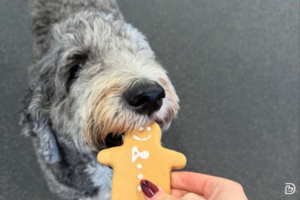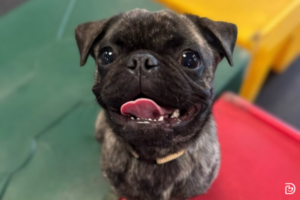Dog Dental Health Tips

Maintaining your dog’s oral health is essential to maintaining their overall wellbeing. However, as many pet parents can attest, keeping up with this part of their pup’s hygiene routine is not necessarily the easiest task, especially when dealing with active, squirmy pups who cannot sit still long enough to have their teeth brushed.
Beyond treating your dog’s bad breath, which is often the first sign of poor dental health, teeth brushing removes plaque buildup caused by leftover food and bacteria. If this plaque is not stopped in its tracks, it hardens and can lead to further oral health problems, such as broken and cracked teeth, and other adverse results in the body if the bacteria enter the bloodstream. Tartar (aka hardened plaque) is comprised of 80% bacteria and can damage the gumline, bone, and ligaments that hold teeth in place.
To maintain your dog’s beautiful smile, we have put together some tips to boost their dental health and help enhance their overall oral hygiene so they can live their healthiest, happiest life.
BRUSH THEIR TEETH REGULARLY
While this might be a more obvious dental health tip, it’s crucial to brush regularly. Brushing your dog’s teeth may take some time to get used to, so start slowly and in a calm, comfortable space.
If you can, purchase a toothbrush made just for dogs, as they are often designed with angled handles and small bristles, making it easier to get to those hard-to-reach places. Dog toothpaste is also important because it is safe for your pup to swallow (human toothpaste has ingredients not safe for pups to ingest). Various flavors, like poultry, beef, and peanut butter, are available, so find one your dog likes to make the experience more enjoyable.
A great way to start is by touching your dog’s teeth and gums without the toothbrush, just to get them used to it. Then, introduce the toothbrush and toothpaste separately until you and your pup feel comfortable starting the teeth-brushing process. If at any time you find your dog is highly uncomfortable or agitated, stop and reach out to your vet for support.
How often should you brush your dog’s teeth? Three times a week is a recommended minimum, but some pet parents try every day. Around 30 seconds on each side is often enough, but take into account mini breaks during this time.
CHOOSE CHEW TOYS
What kind of toys are at your pup’s disposal? If they are primarily soft, stuffing-filled ones, you may want to add in safe, bendable chew toys that they bite and chomp on. Chewing on these toys can help maintain their teeth and gum health, as the action helps remove plaque, while also helping keep bad breath at bay. To your pup, this is just a new toy added to their playtime mix, and they’ll be blissfully unaware that they’re improving their dental health.
If you have an older dog or a dog with pre-existing dental issues, please consult a professional before introducing hard toys to help prevent potential injuries.
CHANGE THEIR WATER BOWL FREQUENTLY
Eliminating the introduction of bacteria into your dog’s mouth can help keep things fresh and clean, and one way to do this is by making changes in an area your pup frequently visits—their water bowl.
A study found that a dog’s water bowl takes third place as the most contaminated item in a home, particularly when made from a ceramic or plastic material. Regularly changing out the water in your pup’s bowl (at least once a day) can help keep the environment sanitary and remove any buildup that forms. If your canine companion happens to be a heavy drooler, you’ll want to up the number of times you change their water to around two to three times daily.
Not only can doing this help your dog’s oral health, but fresh water is much more appealing to pups than stale water, making it a win-win!
USE A WARM WASHCLOTH
While using proper teeth brushing tools is important and should be used regularly, you may find that it’s also helpful and more convenient to approach your dog’s dental health more spontaneously, and that’s where washcloths can come in handy.
Wipe down your dog’s teeth using a clean, warm washcloth, especially after eating. This can help remove excess food, bacteria, dead cells, and extra saliva. Keep some washcloths on hand to make this process feel more natural and part of your pup’s meal routine.
SWITCH UP THEIR DIET
Making small changes to what your dog eats can positively impact their dental health. Once you receive the all-clear from your vet, introduce dog-safe fruits and vegetables like carrots, apples, celery, and other snacks that provide a crunch to help remove and prevent tartar and keep their breath fresh. The nutrients and antioxidants within these healthy options can also help strengthen your pup’s teeth and gums.
If you’re looking for a natural way to freshen up your dog’s breath, try adding parsley to their food.
TRY DENTAL TREATS AND WATER ADDITIVES
Dental chews are a common staple on pet store shelves and can be a solid option (if your vet approves) to add to your pup’s dental hygiene routine. Finding one your dog enjoys can be a great way to stay on top of their dental health. Remember, these treats should not replace regular brushing but can be a helpful aid, as some areas of the mouth may be missed when dogs chew on these treats.
In addition to dental-specific treats, there are several products on the market, like water additives, that can help keep plaque and tartar in check and reduce bad breath. Again, this should not replace regular brushing, and it is always a good idea to run it by your vet before purchasing.
STOP BY FOR A SPA DAY AT DOGTOPIA
Our spa team knows the tips and tricks to make the teeth-brushing experience comfortable for dogs of any size, breed, and comfort level. Leave it in our capable hands and rest assured that quality products and tools are being used to improve your dog’s dental health with every visit. We also offer a range of other spa treatments that can be added, providing complete pampering for your furry friend.
Contact your local Dogtopia today to find out more.
(Photo courtesy of instagram.com/dogtopiaharrisonave)











